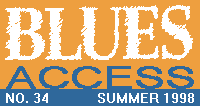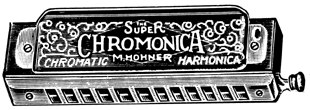

 | ||
| The Doctor is In! |

Dear Harpo,
I've looked at several EQ foot pedals, and most have seven bands. Some have a "control" adjustment, and some do not. Is the control adjustment the same thing as a "gain" control? Would you recommend an EQ and the number of bands necessary, as well as how you use your gain control? Also, would you place the EQ before the delay pedal or after?
Thanks a lot!
Tom Hunt
Hollywood, CA
The Physician of Third Position scrubs up, paying special attention to finesse each ear with a bottle brush of the finest pure badger so as not to miss the smallest nuance of frequency modulation in the chorus of voices that swarm in his head like the blue water in the plumbing fixtures. Why must they torment him, he muses. Why must they always call collect?
Dear Tom,
Good questions. Hopefully, good answers. The "control" adjustment is a volume setting by another name. It allows you to pre-set a specific volume setting when you stomp the foot pedal or whatever you do to activate the EQ. When you switch the pedal on, it goes to the volume you set it for. This is very useful for presetting volume and EQ settings for a specific purpose, like solos. If you tune out the screaming feedback frequencies, you can boost the bejeezus out of your volume for solos without vaporizing everyone's eardrums with feedback.
"Control" (that is, volume) does not equal "gain." Gain boosts the amount of signal that your pedal sends to the amplifier. They're similar but also quite different in their effect. Turning up the volume control is like moving closer to someone to hear them talking to you: Same sound, but louder. Turning up the gain control is like standing in one place and asking the person speaking to you to holler so that you can hear them better. Louder, but more distortion. So use the gain to color the sound, then use volume to get more of the sound that you decide you like to come out of the speakers.
As to specific recommendations, I don't have just one in mind that stands out. Get a seven-band or more with a foot switch and gain control. Volume control is nice but not essential. Don't drop more than a hundred bucks.
I set my EQ with every frequency in the positive position, with the lowest and highest just about flat and the rest going in a nice even triangle to the middle band (around 4-5K), which I max out. Other promising configurations, all based on maxing out the mid-range, are a bell-curve and a semicircle. There is no set recipe for settings, owing to the variables of room size, resonance of the walls (or out of doors, too), your choice of amps and mikes and harps, what sound you are trying to achieve and the big variable -- your playing style. The cool thing about a good EQ is that added versatility it gives to harp players to not only avoid feedback but to customize your sound.
I use the gain control to break up the sound just enough to give it a nice rip, which is about 5/8 of the way to full-on. You'll know when you get it right because you'll start smiling a lot.
EQ before delay, if you value your ears and sanity. The EQ should fine-tune the sound that you then fill out with your delay. Reversing the process will cause feedback because you're giving the amp too constant a signal from offending frequencies on the EQ as you try to set it up. Bad news.
Hope that all of the above will help you navigate
through a very touchy process. If you're meticulous and
patient (take lots of notes, so you remember what works), you
should be able to customize your sound with tremendous flexibility.
Good luck!
The dapper Doc-head gingerly handles the next missive. "I remember this guy," he muses with a flash of brilliance that could be mistaken for inspiration, but in fact was only his mood ring falling into the slot of the toaster in which he was drying his freshly-laundered and reblocked toupee. Engrossed, he slathers rubber cement on his Melba toast, and a man-sized portion of rose hip jelly with a husky rasher of anchovy fillets on his capital dome. This could be dicey.
Dear Harpo,
Thanks for your advice on amps. I sold my Fender Blues Deluxe and got a SJB "Ant" from the U.K. It had two 6V6s pumping out 16 watts through a 12-inch speaker, with older type pre-amp tubes and custom-made transformers. As soon as I plugged it in, it made a crackling sound through the speaker, in both inputs, with a guitar plugged in. When I plugged in my mike, as soon as I touched the volume control I knew I was in feedback hell!
I tried both inputs with two different mikes and twigged the single volume control and tone control every which way, but no luck. Just tons of feedback no matter how far away I stood. The SBJ Audio amp sounded similar to an old Gibson amp which I read about in the Pete Sheridan book The Quest for Tone in Amplified Blues Harp. The advertising even stated that it was equally aimed at guitarists and harp players. I also received a pamphlet and cassette from Sonny Jr. Amps. That is exactly the tone I am looking for! I just hope Sonny is still making them when I get out in 2004!
Keep the Blues alive!
John Carroll
Fulham Prison,
Victoria, Australia
Dear John,
Something is definitely wrong with that amp! Two (or more) things, actually. Cracklesinterrupted, signalloose something or other, somewhere. Could be a connection in the guitar, so rule this out by plugging something that you know functions perfectly into the amp, using a cord that you also know is 100 percent functional. If it still crackles in both inputs, chances are that the problem is not in the input jacks, i.e. they probably didn't both simultaneously conk out.
Next, carefully jiggle the speaker wires and see if that influences the noise. If any wire causes the crackling, reconnect it or replace it. Also, unplug any external stuff, like reverb foot pedals, and see if that eliminates the noise. While you're back there, look for signs of alteration, such as new wiring, cuts in non-original places or any evidence that a previous owner altered the amp. I can't help you solve problems arising out of a failed attempt to rewire the amp; you'll have to consult an expert locally, and I am neither expert nor local.
I doubt that you have a problem with loose tubes, judging by your description of the problem, because loose tube sockets will only crackle if you move the amp or somehow cause them to move, whether with your fingers wiggling them or by sound going through the speakers shaking them around. Check every wire by gently moving it around and isolate the offending loose one. Work in an orderly and systematic fashion so you don't miss the offending connection.
As to the feedback problem, it seems that, assuming that both of the mikes that you used to try out the amp are functional, there is too high a signal coming out of the amp to the speaker. You didn't mention whether the guitar sound was heavily distorted, which would give a reason for your feedback with a mike.
If the guitar sounded OK, except for the crackling, then the problem may be a mismatch between the mike and amp on impedance. Check for a switch on the amp, as any amp advertising itself as intended for harp players would be able to match with various microphones. The mike may also have a hi/lo impedance switch. If the guitar sounded distorted, someone did some hoodoo to the amp to jack up the power output for some power-hungry previous owner. Unfortunately, this happens often with used amps, and requires additional amp surgery to reverse.
If the mike works well with another amp, you can rule out malfunction within the mike. The only other possibility is that the amp is intended for a different amount of current coming out of the wall than what Australian house current provides. American amps will misbehave in the manner you describe if plugged into European current without an adapter -- just before they go up like a toupee in a toaster in a cloud of very smelly and expensive smoke! Look for some schematics or other factory information in the back of the amp. My guess, however, is that the amp is a lunch box, and you deserve a refund and the amp deserves a burial at sea.
As to the greater and original problem of getting you an amplifier, Sonny Jr. told me that one of the inspirations for his amp design was an old Webcor reel-to-reel tape recorder with 6-inch oval speakers which gave that ripped-up sound he now has captured in his amps. Have you tried plugging into various tube-driven devices like old stereos or mono hi-fis, P.A. amps, tape recorders, etc? An amp is an amp, and you can easily obtain a whole set of plug adapters to accommodate most plug-in configurations that you'll encounter to allow you to plug your mike into almost anything pluggable. Try anything that has even a remote chance of sounding good.
Avoid TV sets, as they store lethal amounts of current in capacitors long after they are unplugged. A telephone mouthpiece played through an answering machine sounds pretty good, for example. You might find some diamond in the rough that someone else thinks is a piece of junk. Certainly the price will be right!
Also, check in the library for books on electronics projects. How hard can it be to hook up a simple amp to a small speaker? Especially since we're talking about low fidelity, you may be able to build yourself a hell of an amp for next to nothing and customize it any way that you want. If you're not up to the task, there probably is someone else around with the expertise to either build it for you or coach you through the project. If you have Internet access, search for plans and sources of materials. Let us know how things turn out. Good luck!
Whew! After that workout, the sawbones of harp tones needs to unplug his own cranial capacitors before he turns into a quivering jelly of crackling quackery. As he drifts off into the land of amplified phantasms, he muses, "Hmmm ... Mike Malfunction and the Loose Wires. That might make a good name for my next band." Sweet dreams, Doc. Don't forget to write when you get work.
Got a query for our harmonical medic of musical meditation? Send it in, along with your spare dollar bills and Subgenius pamphlets to Dr. Harp c/o BLUES ACCESS:
 |
 |